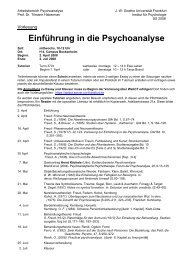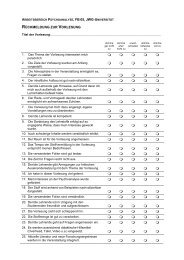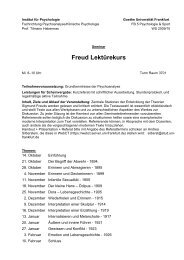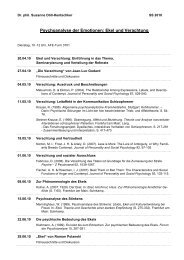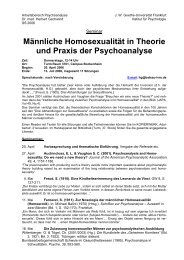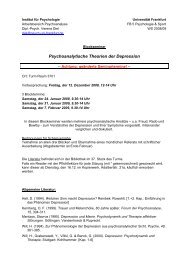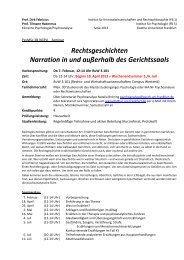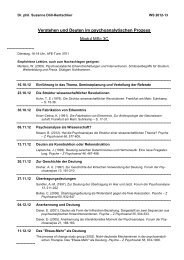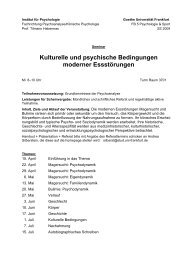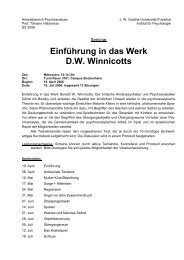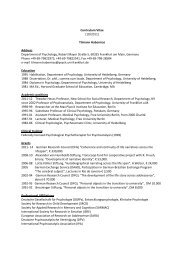Institut für Psychologie - Psychoanalyse - Goethe-Universität
Institut für Psychologie - Psychoanalyse - Goethe-Universität
Institut für Psychologie - Psychoanalyse - Goethe-Universität
Sie wollen auch ein ePaper? Erhöhen Sie die Reichweite Ihrer Titel.
YUMPU macht aus Druck-PDFs automatisch weboptimierte ePaper, die Google liebt.
<strong>Institut</strong> für <strong>Psychologie</strong><br />
<strong>Goethe</strong> Universität Frankfurt<br />
Fachrichtung <strong>Psychoanalyse</strong>/Klinische <strong>Psychologie</strong><br />
FB 5 <strong>Psychologie</strong> & Sport<br />
Prof. Tilmann Habermas WS 2009/10<br />
Seminar<br />
Emotion & Narration<br />
Mi 10–12 Uhr Turm Raum 3701<br />
Teilnahmevoraussetzung: Grundkenntnisse der <strong>Psychoanalyse</strong><br />
Leistungen für Scheinvergabe: Aktive Teilnahme, Referat mit schriftlicher Ausarbeitung, Erhebung<br />
von Emotionserzählungen<br />
Inhalt, Ziele und Ablauf der Veranstaltung: Ausgehend von der Bedeutung des Erzählens für die<br />
Verarbeitung emotionaler Erfahrungen im Alltag wie in der psychoanalytischen Psychotherapie,<br />
untersucht das Seminar die eine Systematik narrativer (Zuhörer-)Emotionen, die Rolle und den Ort<br />
von Emotionen in Erzählungen, die Beziehung zwischen spezifischen Emotionen und formalen<br />
Eigenschaften von Erzählungen, die Veränderung von Erzählungen mit fortschreitender Bewältigung,<br />
sowie den Effekt des Erzählens auf Bewältigung von emotionalen Erlebnissen. Das Seminar stellt<br />
überwiegend grundlagenpsychologische Fragen (Emotionspsychologie, Erzählforschung) an ein<br />
Phänomen mit großer klinischer Bedeutung. Alle Teilnehmenden erheben im Laufe des Semesters<br />
mehrere Emotionserzählungen, transkribieren und analysieren diese.<br />
Handout + Präsentation + Referat bitte mit Angabe des Referattermins schicken an Andrea<br />
Silberstein, die diese in WebCT (https://webct.server.uni-frankfurt.de) stellen wird: silberst@stud.unifrankfurt.de<br />
Themen:<br />
14. Oktober Einführung<br />
21. Oktober Struktur der Alltagserzählung<br />
28. Oktober Alltagserzählung als Kommunikation<br />
4. November Struktur von Emotion<br />
11. November Emotion und Erzählung<br />
18. November Emotionen in der Struktur von Erzählungen<br />
25. November Emotionsspezifische Erzählungen<br />
2. Dezember Traumatische Emotion und Erzählung<br />
9. Dezember Konfliktabwehr und Erzählung<br />
16. Januar Erzählen als Bewältigen<br />
13. Januar Erzählen in der Psychotherapie: Bewältigen<br />
20. Januar Auswertung der selbst erhobenen Emotionserzählungen<br />
27. Januar Empathische<br />
3. Februar Narrative Emotionen<br />
10. Februar Narrative Emotionen und Perspektivendarstellung
2<br />
* Pflichtlektüre, in Reader, erhältlich im Kopierwerk in der Adalbertstrasse 21a. Bücher mit § stehen im<br />
Handapparat, Artikel mit § im Ordner im Handapparat, % heißt sie sind herunterladbar über die UB.<br />
I. Erzählung und Emotion<br />
21. Oktober Struktur der Alltagserzählung - Labov<br />
* Labov, W., & Waletzky, J. (1967). Narrative analysis: Oral versions of personal experience. In I. Helm (Ed.),<br />
Essays on the verbal and visual arts. Proceedings of the 1966 Annual Spring Meeting of the American<br />
Ethnological Society (pp. 12–44). Seattle, WA: University of Washington Press. [download von<br />
http://www.clarku.edu/~mbamberg/LabovWaletzky.htm]<br />
Labov, W. (1997). Some further steps in narrative analysis. Journal of Narrative and Life History, 7, 395–415.<br />
[download von http://www.ling.upenn.edu/~wlabov/sfs.html]<br />
§ Deppermann, A., & Lucius-Hoene, G. (2001). Rekonstruktion narrativer Identität. Ein Arbeitsbuch zur Analyse<br />
narrativer Interviews. Vs Verlag.<br />
28. Oktober Alltagserzählung als Kommunikation<br />
* Fiehler, R. (1990). Kommunikation und Emotion. Berlin: de Gruyter. (S. 230–238, Transkripte 6, 8; S.300, 304)<br />
Tannen, D. (1984). Conversational style: Analyzing talk among friends. Oxford: Oxford University Press. [5.<br />
Kap., Narrative strategies, 123–162]<br />
§ Quasthoff, U. M., & Becker, T. (2004) (Eds.). Narrative interaction. Amsterdam: Benjamins. [H VII 73]<br />
4. November Struktur von Emotion<br />
* Oatley, K., & Jenkins, J. (1996). Understanding emotions. New York: Blackwell. [4. Kapitel: What is an<br />
emotion, pp. 95–131].<br />
§ Frijda, N. (1986). The Emotions. Oxford: Oxford University press. [9. Kap. Theory of emotions, 453–479].<br />
Parkinson, B., Fischer, A. H., & Manstead, A. (2004). Emotion in social relations. London: Psychology Press. [1.<br />
Kapitel, 1–24]<br />
11. November Emotion und Erzählung<br />
* Lazarus, R. S. (1999). Stress and emotion. New York: Springer (Kap. 8+9).<br />
§ Lazarus, R. S. (2006). Emotions and interpersonal relationships: Towards a person centered<br />
conceptualization of emotions and coping. Journal of Personality, 74, 9–46.<br />
§ Voss, C. (2004). Narrative Emotionen. Berlin: deGruyter.<br />
II. Spezifische Emotionen und Erzählstruktur<br />
18. November Spezifische Emotionen in der Struktur von Erzählungen<br />
*§ Hogan, P. C. (2004). The mind and its stories. Cambridge, UK: Cambridge UP. [pp. 76–101]<br />
25. November Emotionsspezifische Erzählungen<br />
* Habermas, T., Meier, M., & Mukhtar, B. (im Druck). Are specific emotions narrated differently Emotion.<br />
§ Hudson, J. A., Gebelt, J., Haviland, J., & Bentivegna, C. (1992). Emotion and narrative structure in young<br />
children’s personal accounts. Journal of Narrative and Life History, 2, 129–150.<br />
§ Peterson, C., & Biggs, M. (2001). “I was really, really mad!” Children’s use of evaluative devices in narratives<br />
about emotional events. Sex Roles, 45, 801–825.<br />
III. Unbewältigte Emotionen und Bewältigen durch Erzählen<br />
2. Dezember Traumatische Emotion und Erzählung<br />
§ Janet, P. (1919). Les médications psychologiques. Paris: Alcan [Band 2, S. 268–292] (Kopiervorlage)<br />
§ Janet, P. (1929). L’Évolution psychologique de la personnalitè. Paris: Chahine. [S. 285–299]) (Kopiervorlage)<br />
% Laub, D., & Auerhahn, N. (1993). Knowing and not knowing massive psychic trauma: forms of traumatic<br />
memory. International Journal of Psychoanalysis, 74, 287–304.<br />
* Foa, E. B., Molnar, C., & Cashman, L. (1995) Change in rape narratives during exposure therapy for<br />
posttraumatic stress disorder. Journal of Traumatic Stress, 8, 675–690.<br />
% Haligan, S. L., Michael, T., Clark, D. M., & Ehlers, A. (2003). Posttraumatic stress disorder following assault:<br />
The role of cognitive processing, trauma memory, and appraisals. Journal of Consulting and Clinical<br />
Psychology, 71, 419–431.<br />
% Mossige, S., Jensen, T. K., Gulbrandsen W., Reichelt, S., & Tjersland, O. A. (2005). Childrens’ narratives of<br />
sexual abuse. Narrative Inquiry, 15, 377–404.<br />
9. Dezember Konfliktabwehr und Erzählung - Freud,<br />
* Habermas, T. (2006). Who speaks Who looks Who feels Point of view in autobiographical narratives.<br />
International Journal of Psychoanalysis, 87, 497–518.
3<br />
Labov, W. (2003). Uncovering the event structure of narrative. In D. Tannen & J. E. Alatis (Eds.), Georgetown<br />
round table on languages and lingiistics (pp. 63–83). Washington DC: Georgetown University Press.<br />
[download von http://www.ling.upenn.edu/~wlabov/uesn.pdf]<br />
§ Ferrara, K. W. (2002). Blocking emotions: The face of resistance. In S. R. Fussell (Ed.), The verbal<br />
communication of emotions (S. 253–279). Mahwah, NJ: Erlbaum.<br />
§ Eisenmann, B. (1995). Erzählen in der Therapie. Opladen: Westdeutscher Verlag. [5., 8., 9. Kap.]<br />
§ Oatley, K. (1992). Best laid schemes. Oxford: Oxford University Press. [7. und 9. Kapitel]<br />
16. Dezember Erzählen als Bewältigen<br />
* Rimé, B. (2009). Emotion Elicits the Social Sharing of Emotion. Emotion Review, 1, 60–85. [download<br />
http://emr.sagepub.com/cgi/reprint/1/1/60]<br />
% Pennebaker, J. W., Mayne, T. W., & Francis, M. E. (1997). Linguistic predictors of adaptive bereavement.<br />
Journal of Personality and Social Psychology, 72, 863–871.<br />
% Lepore, S. J., Ragan, J. D., & Jones, S. (2000). Talking facilitates cognitive-emotional processes of<br />
adaptation to an acute stressor. Journal of Personality and Social Psychology, 78, 499–508.<br />
§ Habermas, T., & Berger, N. (zur Veröffentlichung eingereicht). Retelling five specific everyday emotional<br />
events: Condensation, distancing, and closure.<br />
13. Januar Erzählen in der Psychotherapie: Bewältigen<br />
* Stiles, W. B., Honos-Webb, L., & Lani, J. A. (1999). Some functions of narrative in the assimilation of<br />
problematic experience. Journal of Clinical Psychology, 55, 1213–1226.<br />
% Stiles, W. B., Leiman, M., Shapiro, D. A., Hardy, G. E., Barkham, M., Detert, N. B., & Llewely, S. B. (2006).<br />
What does the first exchange tell Dialogical sequence analysis and assimilation in very brief therapy.<br />
Psychotherapy Research, 16, 408–421.<br />
§ Greenberg, Leslie S; Angus, Lynne E. (2004). The contributions of emotion processes to narrative change in<br />
psychotherapy: A dialectical constructivist approach. In L. Angus, L.E. & J. McLeod (Eds), The handbook<br />
of narrative and psychotherapy: Practice, theory, and research (pp. 331–349). Thousand Oaks, CA: Sage.<br />
% Mergenthaler, E. (1996). Emotion-abstraction patterns in verbatim protocols: A new way of describing<br />
psychotherapeutic process. Journal of Consulting and Clinical Psychology, 64, 1306–1315.<br />
20. Januar Auswertung der selbst erhobenen Emotionserzählungen<br />
IV. Narrative Emotionen: Die Zuhörer<br />
27. Januar Empathische Emotionen<br />
* Ben-Ze’ev, A. (2001). The subtlety of emotions. MIT Press. [pp. 92–99; 241–267]<br />
§ Ben-Ze’ev, A. (2001). The subtlety of emotions. MIT Press. [10.–14. Kapitel]<br />
3. Februar Narrative Emotionen<br />
* Tan, E.S.H. (1994). Film induced affect as a witness emotion. Poetics, 23, 7–32.<br />
Aristoteles (n.d.). Poetik. Stuttgart: Reclam. (S. 17–25)<br />
% Mar, R. A., Oatle, K., Hirsh, J., de la Paz, J., & Peterson, J. B. (2006). Bookworms versus nerds: Exposure to<br />
fiction versus non-fiction, divergent associations with social ability, and the situation of fictional worlds.<br />
Journal of Research in Personality, 40, 694–712.<br />
§ Oatley, K. (2004). From the emotions of conversation to the passions of fiction. In A. S. Manstead, F. Frijda<br />
N., & A. Fischer (Eds.), Feelings and emotions: The Amsterdam symposium. (pp. 98–115). New York, NY:<br />
Cambridge UP.<br />
% Oatley, K. (1994). A taxonomy of emotions of literary response and a theory of identification in fictional<br />
narratives. Poetics, 23, 53–74.<br />
% Oatley, K. (1999). Why fiction may be twice as true as fact: Fiction as cognitive and emotional simulation.<br />
Review of General Psychology, 3, 101–117.<br />
% Zillmann, D. (1994). Mechanisms of emotional involvement with drama. Poetics, 23, 33–51.<br />
§ Weizman, E. (2004). Interpreting emotions in literary dialogue. In E. Weigand (2004), Emotion in dialogic<br />
interaction (pp.241–254). Amsterdam: Benjamins. [O XI 214]<br />
10. Februar Narrative Emotionen und Perspektivendarstellung<br />
* Habermas, T., & Diel, V. (im Druck). The emotional impact of loss narratives: Event severity and narrative<br />
perspectives. Emotion.<br />
§ Goldie, P.(2004). Narrative, emotion, and perspective. In B.Hurwitz, T. Greenhalgh, & V. Skultans (Eds),<br />
Narrative Research in health and Illness (pp. 52–72). New York: Blackwell.<br />
% Habermas, T., Ott, L. M., Schubert, M., Schneider, B., & Pate, A. (2008). Stuck in the past: Negative bias,<br />
explanatory style, temporal order, and evaluative perspectives in life narratives of clinically depressed<br />
individuals. Depression and Anxiety, 25, E121–E132.



